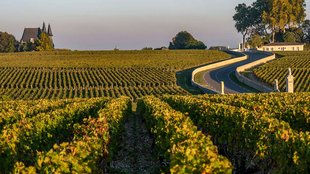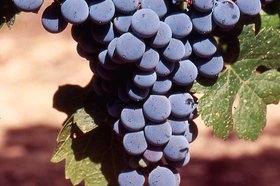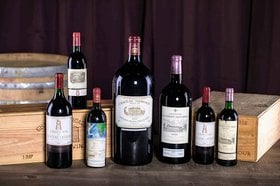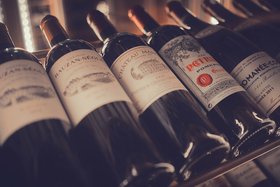Bordeaux Wine Region 101 (Sub-Regions, Wine Styles & more!)
The Bordeaux wine region in the southwest of France is one of most prestigious and prolific wine producing areas in the world.
The wine region has over 7,500 producers, 10,000 different wines, and over 111,000 hectares of stunning vineyards in the picturesque countryside.
The wines range from affordable Bordeaux appellation table wines to some of the most expensive labels.
In this article, take a tour of its sub-regions, wine styles, grapes used, and the climate. We’ll also show you how to find the perfect Bordeaux wine for your needs.
Further reading
- Discover the Perfect Red Wine for your next dinner party.
- Want to try out more wines from the region - check out these fabulous French Wines.
The Bordeaux Wine Region and Its Sub-Regions
The red Bordeaux blend of Merlot, Cabernet Sauvignon, Petit Verdot, Malbec, and Cabernet Franc (small amounts of Carmenere) is one of the most replicated ones in the world.
Just one look at the wine map of the Bordeaux region, and you’ll see why wine lovers flock there for wine tasting and wine tour events!
The wine region surrounds Bordeaux city and is next to the Dordogne, Garonne, and Gironde rivers. This makes it the ideal setting for winemakers with its short winters, temperate climate, and the Atlantic Ocean’s humidity.
The Bordeaux wine region is divided by the Gironde Estuary into the Left Bank and Right Bank regions. There’s also the Entre-Deux-Mers region in between.
Let’s take a look at these sub-regions in more detail.
The Left Bank of Bordeaux

The Left Bank is governed by appellation laws that dictate the alcohol level, viticulture, yields, grape varieties, and winemaking techniques. The Bordeaux region has over 50 Appellation d’origine contrôlées (AOCs.)
The terroir-driven red wines from the Medoc region are the boldest and most tannic of the Bordeaux wine range.
The typical Left Bank Bordeaux blend consists of:
- Cabernet Sauvignon
- Merlot
- Cabernet Franc
- Malbec
- Petit Verdot
Known for its gravelly soils, the Left Bank consists of the prestigious sub-regions - Medoc, Graves, and more.
Medoc
The Medoc region is located on the left bank of the Gironde river with around 10,600 hectares under vine and produces approximately 50 million liters of red wine annually.
Medoc can be further divided into:
- Haut-Médoc: The upper Medoc region consists of six villages with their own appellations (Listrac, Margaux, Moulis, Pauillac, St-Estephe, and St-Julien.) The remaining villages are classified as Haut-Medoc, and wines are predominantly Cabernet Sauvignon.
- St-Estephe: While Cabernet Sauvignon dominates the blends, there are more plantings of Merlot due to the clay soil. Wines from this commune have a heavier acidity and fewer aromas compared to other Bordeaux wines.
- Pauillac: To the south of St-Estephe is the three of the five first-growth chateaux of the Pauillac region - Chateau Lafite-Rothschild, Chateau Mouton Rothschild, and Chateau Latour. The Pauillac region also has 15 other classed growths.
- St-Julien: The St-Julien wine region, situated between Margaux and Pauillac, has the smallest wine production and the highest percentage of classified Chateaux in Bordeaux. 11 cru classe chateaux are responsible for 80% of the St Julien wine region’s output.
- Margaux: The Margaux appellation includes the villages of Arsac, Cantenac, Labarde, Maragaux and Soussans. The appellation has more than 21 classified growths and is home to the first growth Chateau Margaux and several second and third growths.
- CentralMédoc: There are many Crus Bourgeois in Central Medoc, including the Moulis-en-Medoc and Listrac-Medoc appellations. The Listrac appellation produces tannic wine that requires a lot of aging time before they soften.
- Southern Médoc: The southern Medoc region includes classified growths, including Chateau Cantemerle and Chateau La Lagune. Wines produced in this area use the Haut-Medoc designation.
- Bas-Médoc: The lower Medoc region doesn’t have any classified growths. However, it is home to some Cru Bourgeois. Because the Merlot grape favors clay, the wines from the region are sometimes mistaken as Right Bank wines.
Graves
Located on the border of the Garonne river, the Graves wine region is home to the sub-regions of Barsac, Pessac Leognan, and Sauternes.
- Pessac Leognan: The Pessac Leognan region produces both stunning red and white wines. Cabernet Sauvignon, Merlot, Semillon, and Sauvignon Blanc are used in these blends.
- Sauternes and Barsac:Sauternes is known for its decadent white dessert wines made from Botrytis-affected grapes. Barsac is home to Premier Crus such as Chateau Coutet and Chateau Climens. This sweet white wine is typically a blend of Muscadelle, Semillon, and Sauvignon Blanc wine grapes.
Although Chateau Haut-Brion was included in the 1855 classification - red wines from the Graves appellation were only classified in 1953. White wines from the region were added in an update in 1959.
The Right Bank of Bordeaux
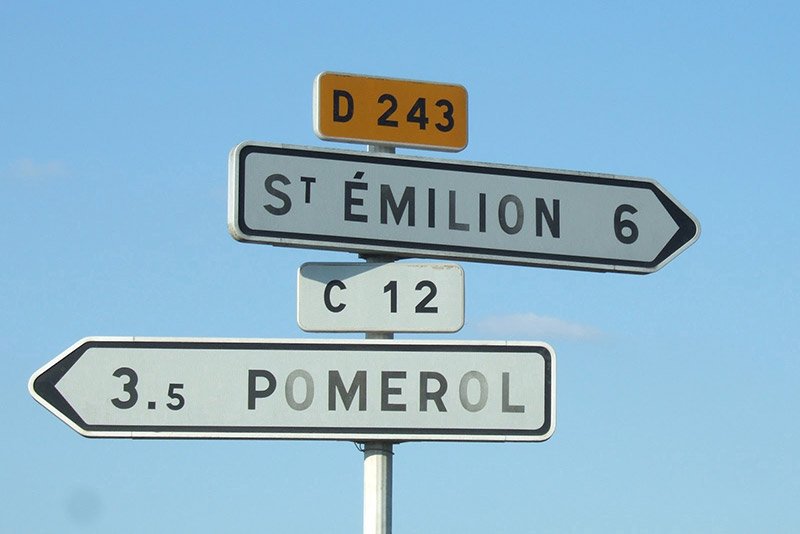
The Right Bank wine region comprises Libournais, Bourg and Blaye, and other smaller appellations.
The wines from this region are bold, have refined tannins, and are dominated by Merlot.
In order of importance, a typical Right Bank Bordeaux Blend includes:
- Merlot
- Cabernet Franc
- Cabernet Sauvignon
Libournais
Libournais is home to the St-Emilion and Pomerol appellations.
- Pomerol: Cabernet Franc gives the red wine from this region its deep coloring and the ability to be consumed in their youth. While there is no classification in the area, Chateau Petrus is considered a First Growth in Bordeaux.
- St Emilion: There are several villages in the commune of St Emilion. The climate and damper soils make it difficult for Cabernet Sauvignon to ripen fully, so Merlot dominates the wines, followed by Cabernet Franc.
Bourg and Blaye
This is one of the oldest wine-producing regions in Bordeaux. Merlot is the star grape variety in this area, followed by Cabernet Sauvignon, Cabernet Franc, and Malbec. Additionally, a large area is planted with Sauvignon Blanc, which is used for sparkling wine.
- Côtes-de-Bourg: This appellation is known for its Bordeaux red wine made from Merlot, Cabernet Sauvignon, Cabernet Franc, and Malbec grapes. There are only 200 Chateaux in this region, including Chateau Falfas, Chateau Bujan, and Chateau Tayac.
Entre-Deux-Mers “Between 2 Tides”
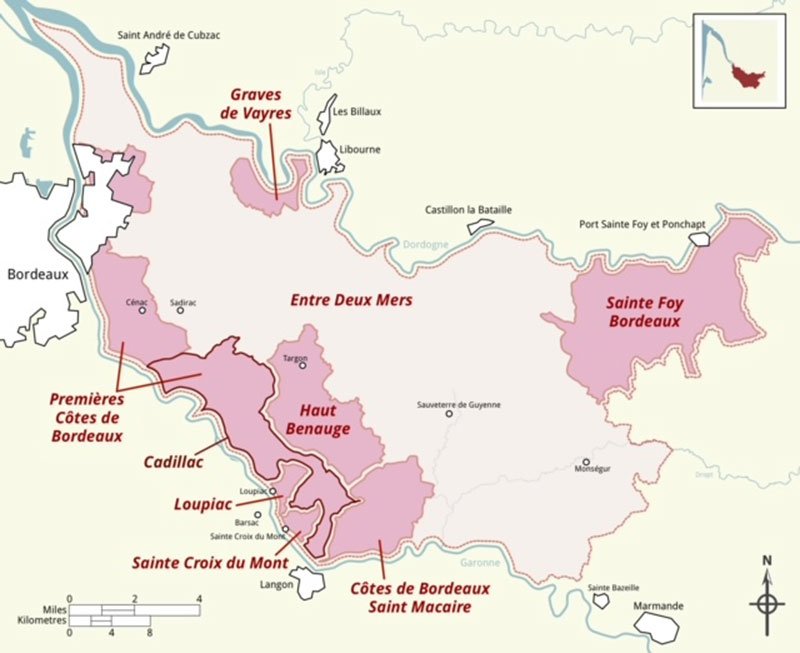
The area between the two major rivers of Bordeaux is known as “Entre-Deux Mers.” Their famous white wines are made from Muscadelle, Sauvignon, and Semillon grapes. Merlot dominates their delicious red wines.
Let’s take a closer look at the region’s climate.
The Climate Of The Bordeaux Wine Region
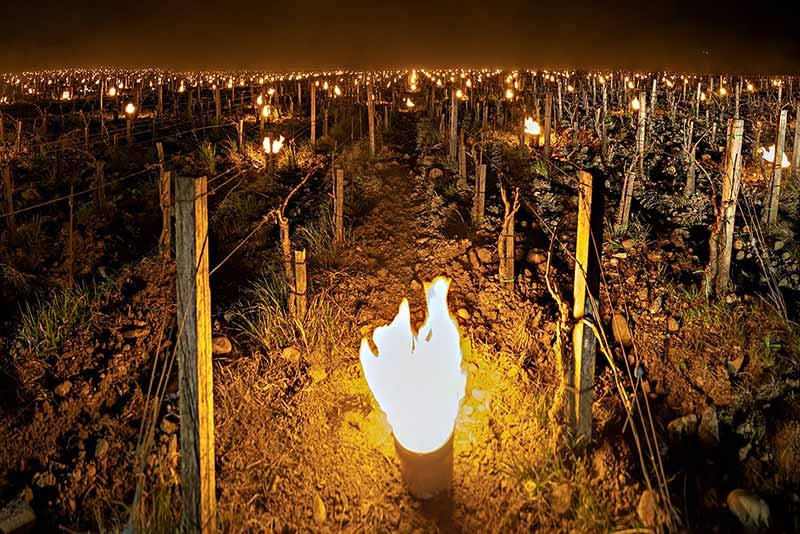
The climate of the Bordeaux wine region is moderated by the three rivers and the Atlantic Ocean.
The long summers in the Bordeaux region are perfect for late-ripening grapes, and the wet spring and autumn seasons are not a concern for growers.
When rain is heavy in autumn, the Cabernet Sauvignon grape varietal suffers, and Merlot steps up. When Merlot suffers during a wet spring, Cabernet Sauvignon then provides a backup for Merlot.
But these are not the only grape varieties grown in the Bordeaux wine region.
Key Grape Varieties Used in Bordeaux
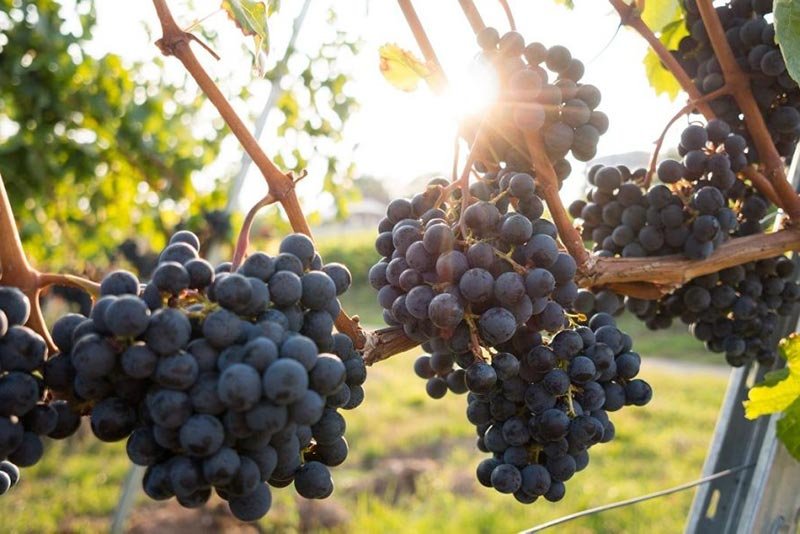
The distribution of red grape varieties in the Bordeaux vineyard plantings is as follows:
- 66% Merlot
- 22.5% Cabernet Sauvignon
- 9.5% Cabernet Franc
- 2% Carmenere, Malbec, and Petit Verdot
Carmenere and Petit Verdot have been abandoned in recent years as they fail to ripen in the Bordeaux region climate.
The distribution of grape varieties used in the stunning dry white wine styles is:
- 47% Semillon
- 45% Sauvignon Blanc
- 5% Muscadelle
- 2% Colombard, Merlot Blanc, Sauvignon Gris, and Ugni Blanc
Six new varieties were approved for vineyard trials by INAO (Institut National des Appellations d'Origine) in 2021. They include the Albarino, Arinarnoa, Castets, Liliorila, Marselan, and Touriga Nacional vines.
Usage of these new grape varietals is limited and may only account for 10% of a Bordeaux wine blend.
Let’s look at the different wine styles from the Bordeaux wine region.
The Wine Styles Of Bordeaux

The beauty of Bordeaux wine lies in the fact that it is a blend of different grape varieties.
Let’s look at the different wine styles you can find in Bordeaux.
1. Red Bordeaux Wine: Red Bordeaux wine accounts for 25% of France's AOC wine production.
Also known as Claret (in the UK), these wines are commonly a blend of the three main grape varieties - Cabernet Sauvignon, Merlot, and Cabernet Franc.
Left Bank red wines have a higher proportion of Cabernet Sauvignon, while the Right Bank has more Merlot.
You should check out these two bottles:
- 1989 Chateau Haut-Brion, Pessac-Leognan: $2596
- 2015 Chateau Margaux, Margaux: $1988
2. White Bordeaux Wines: Typically a blend of Semillon and Sauvignon Blanc, these white Bordeaux whites have fruity flavors.
Sauvignon Blanc, Semillon, and Muscadelle grape varieties are used for white wines in the Graves area. Botrytized dessert wines are made in the Sauternes and Barsac region.
Best wines:
- 2001 Chateau Rieussec, Sauternes, France: $164
- 2001 Chateau Suduiraut, Sauternes, France: $111
3. Sauternes Sweet Wine: These glorious dessert wines have a higher alcohol content and a sweeter taste from the botrytis-affected grapes.
Try these wines:
- 2009 Chateau Climens, Sauternes - Barsac, France: $115
- 1997 Chateau Coutet, Sauternes - Barsac, France: $78
4. Bordeaux Rosé: While it is super rare, the Bordeaux rose does exist! These refreshing wines are blends of Merlot, Cabernet Franc, Cabernet Sauvignon, Petit Verdot, and the Carmenere grape varietal.
Two great wines:
- 2018 Chateau Auguste Rose, Bordeaux, France: $19
- 2019 Chateau Palene Rose, Bordeaux, France: $10
Besides these blends, there are also some varietal wines that are popular:
5. Cabernet Sauvignon: The Cabernet Sauvignon varietal wines are adored for their earthy and oak aromas, herbal flavors, and strong tannins - which aids their aging potential.
Try these wines:
- 1982 Chateau Sociando Mallet, Haut-Medoc: $209
- 2009 Chateau Ducru-Beaucaillou, Saint-Julien: $430
6. Merlot: Merlot varietals don’t require much aging before consuming and are softer with plum flavors.
Best bottles to get hold of:
- 2010 Le Pin, Pomerol: $4513
- 2016 Chateau La Fleur-Petrus, Pomerol: $254
7. Cabernet Franc: Commonly the supporting varietal in Bordeaux, Cabernet Franc varietal wines are known for vegetal notes.
Two delicious bottles:
- 2016 Le Dome Saint-Emilion Grand Cru: $256
- 2016 Chateau Fleur Haut Gaussens 'La Bergeronnette' Cabernet Franc: $25
How do you know which Bordeaux wine is perfect for dinner and which one is ideal for investment?
How to Choose The Perfect Bordeaux Wine
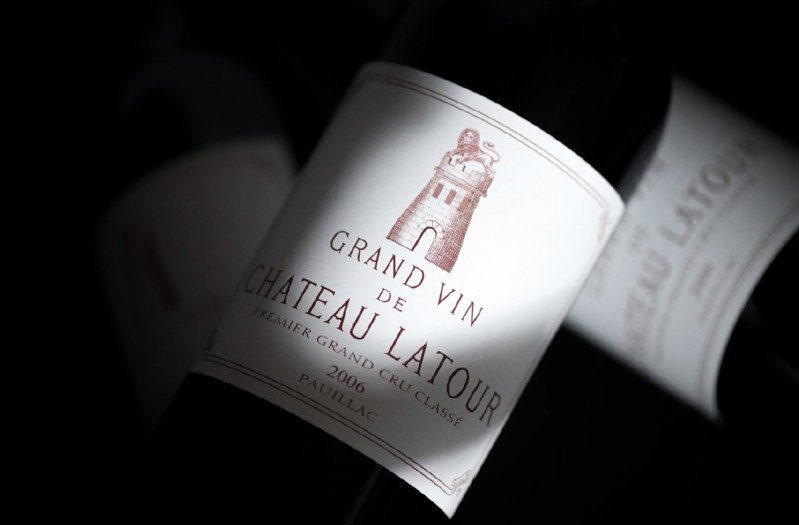
Finding the ideal Bordeaux wine for your needs can be overwhelming.
Here are some excellent tips to make sure you choose the right wine every time.
How to Pick Wines To Enjoy With Family And Friends:
1. Take note of the region: There are 38 sub-regions with 57 appellations in Bordeaux. To get a good picture, you should try out some of the super-affordable wines and some of the most expensive bottles like Petrus as well!
2. Keep the vintage in mind: Keep an eye out for great Bordeaux wine vintages like 2000, 2003, 2005, 2008, 2009, and 2010.
3. Understand the wine label: Just like any French wine, Bordeaux wine labels would have the appellation name, the vintage, the classification, sub-region, and an indication of the blend. So make sure you go through them carefully.
How to “Invest” in Bordeaux Wines
Bordeaux accounts for over 80% of the fine wine investment industry. They dominate fine wine auctions and will remain an essential currency for anyone interested in wine.
The simplest way to find the right Bordeaux wine for your investment style is through a world-class wine investment company.
Vinovest helps wine enthusiasts build a high-performing wine portfolio by making buying, storing, and selling fine wines from around the world easy with just a few clicks.
Let’s also look at other interesting aspects of these wines.
Tasting Notes, How To Serve, And Food Pairings For Bordeaux Wine
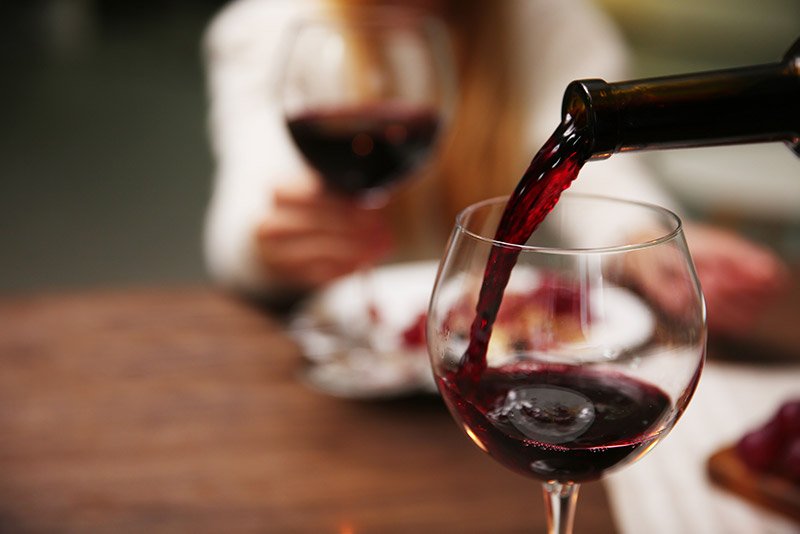
Red Bordeaux Wines
Red Bordeaux wines are medium-full bodied and have a high tannic structure, with typical aromas of earth, gravel, black currant, plum. You will experience plum, cedar, violet, black currant, graphite, minerals, and fruit notes on the palate.
To get the most out of your Bordeaux reds, decant them for 30 minutes and serve them slightly below 65°F.
The bold flavors and high tannins make red Bordeaux wines the perfect pairing for meaty dishes (pepper steak, filet mignon, roasts), White Cheddar, and roasted vegetables.
White Bordeaux Wines
There are two kinds of Bordeaux white wine - rich and creamy or light and fruity.
Light and fruity white wines are the more popular style. These white Bordeaux wines have big aromas and flavors of gooseberry, citrus fruit, honey, passionfruit, honeysuckle, and grass.
However, the rich and creamy white Bordeaux wines offer pears, apples, caramelized grapefruit, ginger, lemon butter, creme brulee, and chamomile notes.
Serve your white Bordeaux wine at 43° - 47°F and your dessert wine at 50°F.
Don’t pair your white Bordeaux with overly acidic foods. To complement the fresh flavors of Bordeaux white wine, pair it with light pasta dishes and light fish dishes.
If you're in the UK you can get a case of fine Bordeaux wine at VinoSelect.
Lastly, let’s look at the region’s origin story too.
How Bordeaux Wines Rose To Fame
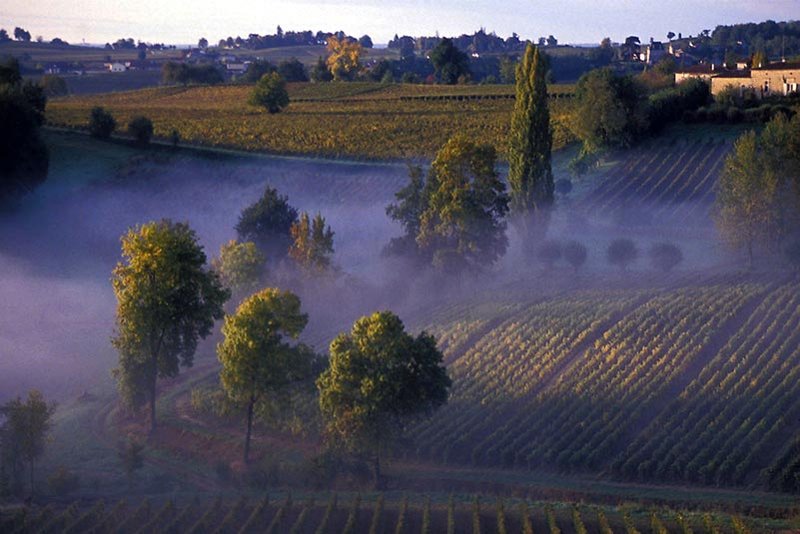
Bordeaux being a port town boosted the wine production of the region during the 12th century. During this time, the trade agreement with England made Bordeaux and Burgundy wine affordable to the British.
The Bordeaux wine region was first adored for its gorgeous white wines from the Sauternes region. During the 1700s, rose wine became popular, and the British gave them the name Claret.
It wasn’t until the 1800s that the red Bordeaux wines started to take over. This rise in popularity is what brought about the classification of the top producers.
The “1855 Bordeaux Classification” ranks producers in the Bordeaux wine region on a five-tier system. Since its decree, this classification has had only one adjustment and heavily influences the Bordeaux wine market.
There are other classifications in Bordeaux, including:
- The Graves Classification
- The Saint-Émilion Classification
- The Crus Bourgeois du Médoc Classification
- The Crus Artisans Classification
Experience The Beauty Of The Bordeaux Wine Region
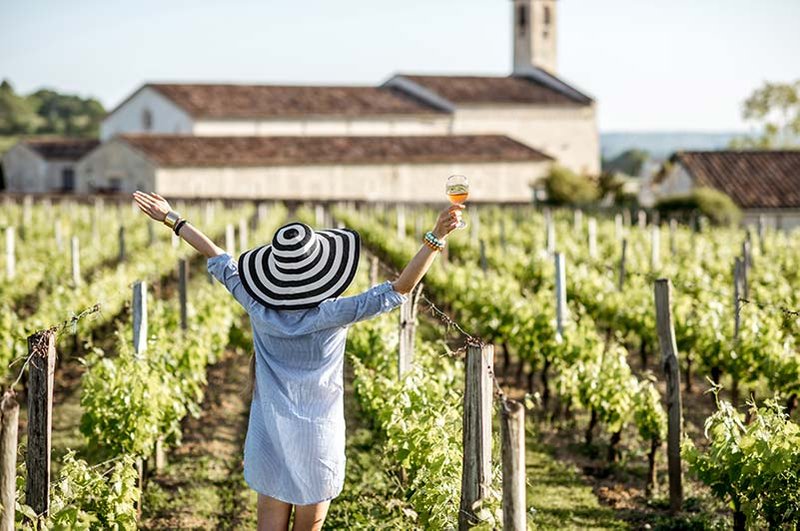
Whether a winery is listed among the First growths or not, the red and white wines from the Bordeaux wine region are definitely worth a try!
Check out the Vinovest website and find out how you can invest in the wonders of the Bordeaux wine region and other fine wine regions.
